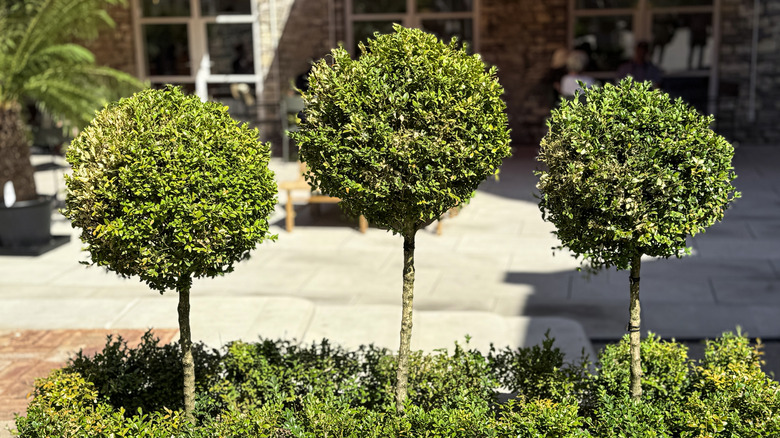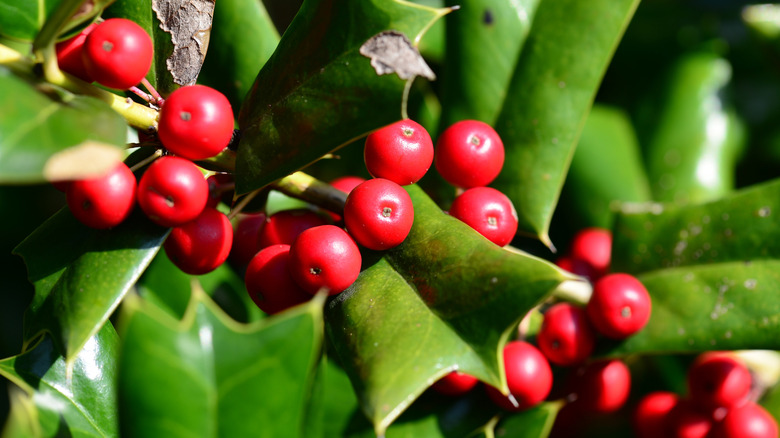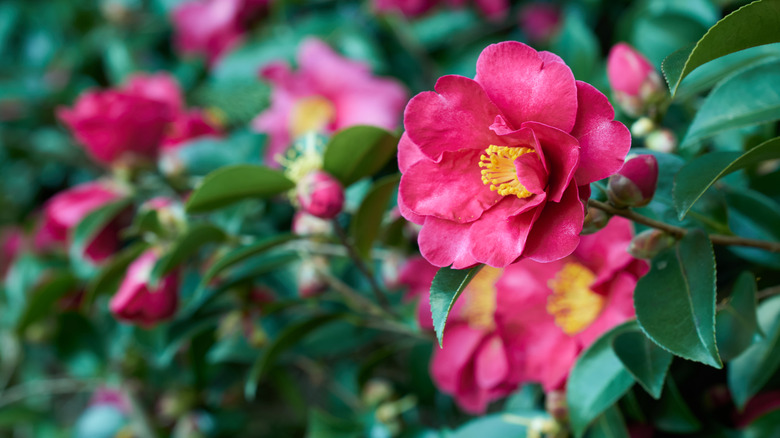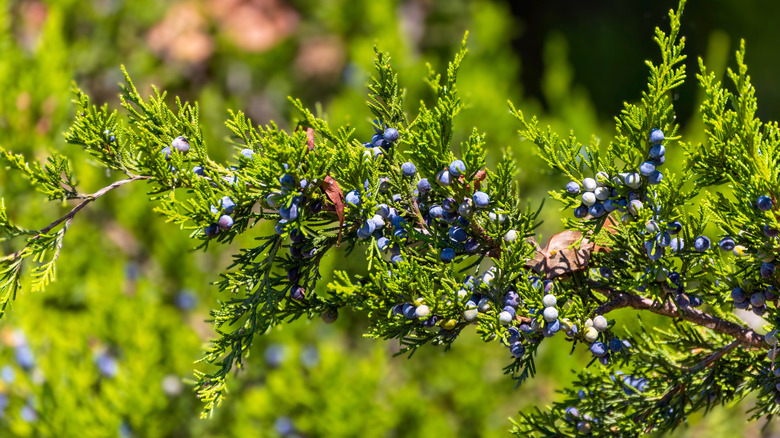Avoid Cutting Back These 11 Evergreens In The Fall At All Costs
Gardens require work all year long. When you aren't fighting off insects, you are planting, prepping, or cutting back growth. For the most part, these things work in a specific cycle, and many projects move with different seasons. However, not every plant grows in the same way and at the same time, and trying to follow your normal cycle with them can cause serious damage to your plants.
For example, pruning is usually thought of as a fall activity. Things are dying off anyway, so it's a good time to pull up annuals and cut back certain plants. However, the rules are a little different for evergreens. For this group of flora, you have to be careful when you cut them back, as doing it at the wrong time can lead to the loss of beautiful flowers, stunted growth, or serious damage to your plant.
There are quite a few evergreens — including boxwoods, coral bells, and holly — that you should really avoid pruning or cutting back in the fall as much as possible. For some of these plants, it doesn't give them enough time to recover, and for others, it can prevent more blooms from coming in the spring. While even the ideal pruning time for each evergreen looks a little different, most of them do best when pruned either just before or after their growing or blooming season.
Coral bells
Coral bells (Heuchera spp.) are beautiful plants that are hardy in USDA zones 4 to 9. In warmer areas in its range, it can be a full evergreen, staying bright all year long. In these situations, you should definitely avoid pruning this perennial in the fall for a stronger, healthier plant in spring. The leaves help to protect the crown from frost damage, so cutting them back can seriously hurt it. Instead, you can prune your coral bells as needed in the spring after your last frost to help promote new and healthy growth.
Stonecrop
If you live in a colder climate, it may be best to avoid fall pruning of stonecrop (Sedum spp.) for a safer and healthier plant. They are hardy in zones 3 to 11, and in the cooler regions, while you can cut off any dead or diseased growth before winter sets in, you should focus on performing the majority of the cutting in spring. This helps to encourage new plant growth, and pruning in the fall instead may cause it to start growing, which will stress it and lead to damaged growth.
Boxwood
Boxwoods (Buxus sempervirens) — hardy in zones 4 through 9 — should rarely, if ever, be cut back heavily in the fall and winter. Even in the warmer parts of their zones, the cooler temperatures make it difficult for the plant to produce new growth and seal off the cuts. In the spring, the damage seals up and heals a lot quicker while also promoting new growth. Since boxwoods are rather slow to grow, this gives the new parts of the plant plenty of time to harden up and become sturdy before cooler temperatures arrive.
Arborvitae
Arborvitae (Thuja occidentalis) is another evergreen tree, and it is hardy in zones 2 to 7. It should almost never be cut back in the fall. First, it helps protect the plant's center from colder temperatures. Additionally, Eric North, program manager of urban forestry and ISA certified arborist at Arbor Day Foundation, says on Martha Stewart's website, "Avoid pruning in the fall, where the additional light to the interior can cause browning or reddening of newly exposed foliage." Instead, cut it back in the spring when the new growth in the center of the plant could do with light.
Holly
Most species of holly (Ilex spp.) are evergreens. There are many varieties, but most of them are able to grow somewhere between zones 4 and 9, with some able to go to extremes from 3 to 11 or 12. You can prune holly when it's dormant in the winter or early spring. This is more ideal for aggressive pruning. Or, if you want to keep your berry production in future years and only need a light cut back, try for after the plant has flowered, but before the end of summer, when new growth could be damaged by colder weather leading into winter.
Red hot pokers
Red hot pokers (Kniphofa spp.), also known as torch lilies, are evergreen red hot flowers that will stand out in your yard while drawing in hummingbirds in zones 5 to 9. In the fall and winter, this plant's foliage starts to droop — a method to protect the center from cold temperatures. Because of this, you don't want to cut it until the threat of frost has passed in the spring, but before new growth appears. You can cut back any dead foliage and make space for new and healthy plants.
Eastern white pine
Eastern white pine (Pinus strobus) is a beautiful tree that's tolerant in zones 3 through 8. In colder areas, cutting this plant back in the fall can lead to damage at the end of the branches due to frost. Instead, cut in the spring. This allows you to trim off new growth, which helps you to better maintain the desired shape of your tree. Pruning before the new growth appears reduces the stress on your plant, which makes it better for aggressive cut-backs, and there is a lower chance for pests and diseases to harm it.
Pacific rhododendron
Pacific rhododendron (Rhododendron macrophyllum) is a beautiful shrub with a rather limited range, found generally in the Pacific Northwest in zones 7 through 9. Like other large evergreens, it's best to prune it in the spring, so the new growth has plenty of time to develop and harden. Generally, you want to do it after it blooms so you can see all the pretty flowers before cutting them back. Speaking of flowers, it produces the buds for the next year in late summer and early fall, so pruning at this time will actually harm the spring blooms.
Camellia
Camellia (Camellia spp.) is a group of beautiful flowering evergreen plants. Most are hardy in zones 7 through 10, but some hardier varieties can handle zone 6. As with many plants, every variety is a little different. However, camellias tend to do best when they are pruned shortly after their last bloom. There are both winter- and fall-flowering varieties, but most of the time, you are looking at starting the work in early spring. Additionally, the buds grow in the late summer and fall, so cutting them during this time will actually reduce the blooms for next year.
Eastern red cedar
The Eastern red cedar (Juniperus virginiana) is an evergreen tree in the cypress family. You can also plant Eastern red cedar trees to maintain privacy and add a soft pop of color, but you have to know how to care for them. This tree grows well in zones 2 through 9, and is native to the region. It does best when pruned at the end of winter to the beginning of spring, right before it starts its new growth for maximum effectiveness and minimum stress. Pruning then helps the plant recover quickly and produce new foliage.
Tea olive
Tea olives (Osmanthus spp.) are one of several trees that deliver continuous blooms for year-round color, which is why it can be a little hard to determine the best time to cut back this plant. It grows in zones 7 to 10 and is absolutely beautiful. Technically, they can be pruned at any time of the year, but most people recommend stopping any work on your plant about two months before the average first frost date. For heavy cutting, you can try and do most of that in winter or early spring, before any new growth.











